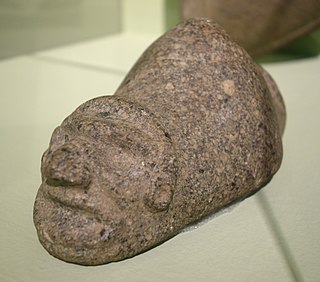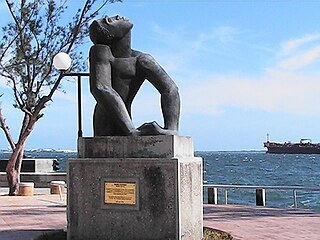Related Research Articles

The Arawak are a group of indigenous peoples of northern South America and of the Caribbean. Specifically, the term "Arawak" has been applied at various times from the Lokono of South America to the Taíno, who lived in the Greater Antilles and northern Lesser Antilles in the Caribbean. All these groups spoke related Arawakan languages.
The Lucayan people were the original residents of The Bahamas before the European conquest of the Americas. They were a branch of the Taínos who inhabited most of the Caribbean islands at the time. The Lucayans were the first indigenous Americans encountered by Christopher Columbus. Shortly after contact, the Spanish kidnapped and enslaved Lucayans, with the displacement culminating in the complete eradication of the Lucayan people from the Bahamas by 1520.

Yúcahu —also written as Yucáhuguama Bagua Maórocoti, Yukajú, Yocajú, Yokahu or Yukiyú— was the masculine spirit of fertility in Taíno mythology. He was the supreme deity or zemi of the Pre-Columbian Taíno people along with his mother Atabey who was his feminine counterpart. Dominant in the Caribbean region at the time of Columbus’ First voyages of Discovery, the peoples associated with Taíno culture inhabited the islands of the Bahamas, the Greater Antilles, and the Lesser Antilles.

Cohoba is a Taíno transliteration for a ceremony in which the ground seeds of the cojóbana tree were inhaled, the Y-shaped nasal snuff tube used to inhale the substance, and the psychoactive drug that was inhaled. Use of this substance produced a hallucinogenic, entheogenic, or psychedelic effect. The cojóbana tree is believed by some to be Anadenanthera peregrina although it may have been a generalized term for psychotropics, including the quite toxic Datura and related genera (Solanaceae). The corresponding ceremony using cohoba-laced tobacco is transliterated as cojibá. This was said to have produced the sense of a visionary journey of the kind associated with the practice of shamanism.

The Parish of Manchester is a parish located in west-central Jamaica, in the county of Middlesex. Its capital, Mandeville, is a major business centre. Its St. Paul of the Cross Pro-Cathedral is the episcopal see of the Latin Catholic Diocese of Mandeville.

A metate is a type or variety of quern, a ground stone tool used for processing grain and seeds. In traditional Mesoamerican cultures, metates are typically used by women who would grind nixtamalized maize and other organic materials during food preparation. Similar artifacts have been found in other regions, such as the sil-batta in Bihar and Jharkhand, India as well as other grinding stones in China.
At the time of first contact between Europe and the Americas, the indigenous peoples of the Caribbean included the Taíno of the northern Lesser Antilles, most of the Greater Antilles and the Bahamas, the Kalinago of the Lesser Antilles, the Ciguayo and Macorix of parts of Hispaniola, and the Guanahatabey of western Cuba. The Kalinago have maintained an identity as an indigenous people, with a reserved territory in Dominica.
Guabancex is the zemi or deity of chaos and disorder in Taíno mythology and religion, which was practiced by the Taíno people in Puerto Rico, Hispaniola, Jamaica, and Cuba, as well as by Arawak natives elsewhere in the Caribbean. She was described as a mercurial goddess that controlled the weather, conjuring storms known as "juracán" when displeased. The latter term was later used to name the climatological phenomenon that is now known as a hurricane in the Western Hemisphere.

A zemi or cemi was a deity or ancestral spirit, and a sculptural object housing the spirit, among the Taíno people of the Caribbean. They were also created by indigenous South Americans. Cemi’no or Zemi’no is a plural word for the spirits. They were also venerated by other Arawak natives in other sides of the Caribbean that weren’t in the Greater Antilles

Ancient Maya art is the visual arts of the Maya civilization, an eastern and south-eastern Mesoamerican culture made up of a great number of small kingdoms in present-day Mexico, Guatemala, Belize and Honduras. Many regional artistic traditions existed side by side, usually coinciding with the changing boundaries of Maya polities. This civilization took shape in the course of the later Preclassic Period, when the first cities and monumental architecture started to develop and the hieroglyphic script came into being. Its greatest artistic flowering occurred during the seven centuries of the Classic Period.

Jamaican art dates back to Jamaica's indigenous Taino Indians who created zemis, carvings of their gods, for ritual spiritual purposes. The demise of this culture after European colonisation heralded a new era of art production more closely related to traditional tastes in Europe, created by itinerant artists keen to return picturesque images of the "new world" to Europe. Foremost among these were Agostino Brunias, Philip Wickstead, James Hakewill and J. B. Kidd.
Caribbean art refers to the visual as well as plastic arts originating from the islands of the Caribbean. Art in the Caribbean reflects thousands of years of habitation by Arawak, Kalinago, and other people of the Caribbean followed by waves of immigration, which included artists of European origins and subsequently by artists with heritage from countries all around the world. The nature of Caribbean art reflects these diverse origins, as artists have taken their traditions and adapted these influences to reflect the reality of their lives in the Caribbean.

The Taíno ritual seat is a Pre-Columbian wooden seat made in the form of a man on all fours. It was made by the Taino people and found in a cave near the city of Santo Domingo in the Dominican Republic. The seat was made before Christopher Columbus landed in the Caribbean and is an important remnant of the Taino culture and civilisation that existed before the arrival of Europeans.

The Taíno were a historic Indigenous people of the Caribbean, whose culture has been continued today by Taíno descendant communities and Taíno revivalist communities. At the time of European contact in the late 15th century, they were the principal inhabitants of most of what is now Cuba, the Dominican Republic, Jamaica, Haiti, Puerto Rico, the Bahamas, and the northern Lesser Antilles. The Lucayan branch of the Taíno were the first New World peoples encountered by Christopher Columbus, in the Bahama Archipelago on October 12, 1492. The Taíno spoke a dialect of the Arawakan language group. They lived in agricultural societies ruled by caciques with fixed settlements and a matrilineal system of kinship and inheritance. Taíno religion centered on the worship of zemis.
The consumption of hallucinogenic plants as entheogens goes back to thousands of years. Psychoactive plants contain hallucinogenic particles that provoke an altered state of consciousness, which are known to have been used during spiritual rituals among cultures such as the Aztec, the Maya, and Inca. The Maya were indigenous people of Mexico and Central America that had significant access to hallucinogenic substances. Archaeological, ethnohistorical, and ethnographic data show that Mesoamerican cultures used psychedelic substances in therapeutic and religious rituals. The consumption of many of these substances dates back to the Olmec era ; however, Mayan religious texts reveal more information about the Aztecs and Mayan civilization. These substances are considered entheogens because they were used to communicate with divine powers. "Entheogen," an alternative term for hallucinogen or psychedelic drug, derived from ancient Greek words ἔνθεος and γενέσθαι. This neologism was coined in 1979 by a group of ethnobotanists and scholars of mythology. Some authors claim entheogens have been used by shamans throughout history, with appearances in prehistoric cave art such as a cave painting at Tassili n'Ajjer, Algeria that dates to roughly 8000 BP. Shamans in Mesoamerica served to diagnose the cause of illness by seeking wisdom through a transformational experience by consuming drugs to learn the crisis of the illness
Areíto or areyto was a Taíno language word adopted by the Spanish colonizers to describe a type of religious song and dance performed by the Taíno people of the Caribbean. The areíto was a ceremonial act that was believed to narrate and honor the heroic deeds of Taíno ancestors, chiefs, gods, and cemis. Areítos involved lyrics and choreography and were often accompanied by varied instrumentation. They were performed in the central plazas of the villages and were attended by the local community members as well as members of neighboring communities.

The statue of A'a from Rurutu is a wooden sculpture of the god A'a that was made on the Pacific island of Rurutu in the Austral archipelago. In the early nineteenth century, the sculpture was given by the islanders to the London Missionary Society to mark their conversion to Christianity. Following this, it was brought back to England to be displayed, first in the museum of the LMS and then in the British Museum. The figure of A'a is famous as one of the finest surviving pieces of Polynesian sculpture, and in the twenty-first century the sculpture is, according to Julie Adams, curator of the Oceania collection at the British Museum "an international celebrity".

Around 650 AD, Jamaica was settled by the people of the Ostionoid culture, who likely came from South America. Alligator Pond in Manchester Parish and Little River in St. Ann Parish are among the earliest known sites of this Ostionoid culture, also known as the Redware culture. These people lived near the coast and extensively hunted turtles and fish.
A snuff tray, also known as a snuff tablet, is a hand-carved tablet or tray that was made for the purpose of inhaling a psychoactive drug (also referred to as being hallucinogenic, entheogenic, or psychedelic, in the form similar to tobacco snuff prepared as a powder using a snuff tube. Snuff trays are best-known from the Tiwanaku culture of the Andes in South America. The principal substance thought to have been inhaled was known as willka, also referred to as cebil, and known as yopó in northern South America and cohoba in the Greater Antilles, where it was also prepared from other species of the genus Anadenanthera.
Taíno creation myths are symbolic narratives about the origins of life, the Earth, and the universe, intrinsically shaped from the nature of the tropical islands the Taíno inhabited. The Taíno people were the predominant indigenous people of the Caribbean and were the ones who encountered the explorer Christopher Columbus and his men in 1492. They flourished across much of the Caribbean for nearly 1,000 years before the arrival of Europeans and were one of the region’s most developed cultures.
References
- ↑ "Clarendon Jamaica-The Third Largest Parish" . Retrieved 20 December 2017.
- ↑ Zemi figures, British Museum Collection, retrieved 15 December 2013
- ↑ Allsworth-Jones, P. (2008). Pre-Columbian Jamaica ([Online-Ausg.]. ed.). Tuscaloosa: University of Alabama Press. p. 8. ISBN 978-0817354664.
- ↑ Ancient American Art In Detail, British Museum Press, p 25
- ↑ "Tainos Symbols and meanings in Puerto Rico | iCoquito.com". Archived from the original on 2016-08-12. Retrieved 2016-08-05.
- ↑ Winter, Joseph C., ed. (2000). Tobacco use by Native North Americans : sacred smoke and silent killer. Norman: Univ. of Oklahoma Press. p. 56. ISBN 0806132620.